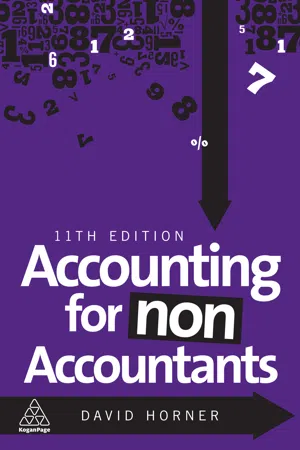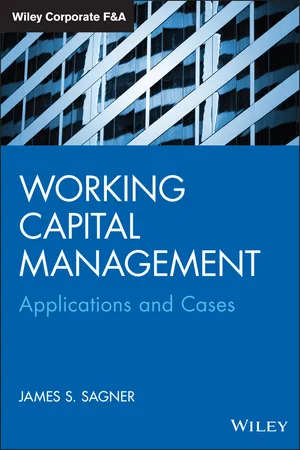Business
Components of Working Capital
The components of working capital refer to the elements that make up a company's short-term operating liquidity. These components typically include cash, accounts receivable, inventory, and accounts payable. Managing these components effectively is crucial for ensuring a company has enough resources to cover its short-term financial obligations and maintain smooth operations.
Written by Perlego with AI-assistance
Related key terms
9 Key excerpts on "Components of Working Capital"
- eBook - ePub
- David Horner(Author)
- 2017(Publication Date)
- Kogan Page(Publisher)
12 Working capital management Introduction A business has two types of capital: fixed capital in the form of non-current assets, such as premises, machinery and equipment; working capital to fund the business operations over the short term. Working capital consists of the current assets and the current liabilities of the business and is calculated as follows: Working capital = Current assets (inventory, trade receivables and cash) less Current liabilities (trade payables and bank overdraft) Current liabilities represent the short-term debts of the business which will require payment in the near future. Cash will be the medium by which these short-term debts will normally be repaid and settled, but having assets which are expected to be converted into cash in the near future will also be important. The assets which can be quickly converted into cash without any significant loss in the asset’s value – the current assets – are considered to be the firm’s liquid assets. Liquidity refers to how quickly an asset can be converted into cash without serious loss in value. Therefore, the business will need to ensure that it has sufficient amounts of working capital (the excess of current assets over current liabilities) in order to pay its debts. The working capital cycle The firm will not simply hold cash ready to pay suppliers and other expenses. Cash will be tied up in various categories as working capital, which will be in a state of constant flux and will be constantly moving between different categories in a cyclical matter. This working capital cycle is shown in Figure 12.1. The working capital cycle works (at least in theory) as follows: a firm will purchase inventory (either as finished goods or as raw materials) on credit from its suppliers (appearing as creditors in the working capital). After production has taken place the finished goods will be sold on to customers as either cash or credit sales (now appearing as trade receivables in the working capital) - eBook - ePub
- David Horner(Author)
- 2020(Publication Date)
- Kogan Page(Publisher)
12Working capital management
Introduction
A business has two types of capital:- fixed capital in the form of non-current assets, such as premises, machinery and equipment;
- working capital to fund the business operations over the short term.
Expenses will need settling in cash. If a business has insufficient cash holdings (either in the business or in the bank account) then it can utilise the liquid assets of the business. It is clearly important that a business manages its working capital carefully.The working capital cycle
The firm will not simply hold cash ready to pay suppliers and other expenses. Cash will be tied up in various categories as working capital, which will be in a state of constant flux and will be constantly moving between different categories in a cyclical matter. This working capital cycle is shown in Figure 12.1 .Figure 12.1 The working capital cycleThe working capital cycle works (at least in theory) as follows: a firm will purchase inventory (either as finished goods or as raw materials) on credit from its suppliers (appearing as trade payables in the working capital). After production has taken place the finished goods will be sold on to customers as either cash or credit sales (now appearing as trade receivables in the working capital). The firm will eventually receive the cash from these credit customers, which in turn can then be used to settle the amounts owing to the credit suppliers as well as any other obligations it has run up during this period, such as wages and other expenses.A firm will wish to minimize the length of its working capital cycle. The longer a firm holds inventories and the longer it takes to collect cash from its customers in respect of credit sales, the more likely it will face liquidity problems. Therefore a firm will want to minimize the time cash is tied up in working capital, so as to avoid potential difficulties with cash flow. - eBook - ePub
Working Capital Management
Applications and Case Studies
- James Sagner(Author)
- 2014(Publication Date)
- Wiley(Publisher)
CHAPTER 1 Concepts in Working Capital Management This chapter covers these topics: Explanation of the basic concepts of working capital. Appreciation for the problems in assigning management responsibility for working capital. Consideration of traditional and modern ideas of working capital management. Understanding the essential focus of cost in working capital management. Applying working capital concepts to a successful company (Best Buy). WORKING CAPITAL is the arithmetic difference between two balance sheet aggregated accounts: current assets and current liabilities. This calculation is done in a currency, such as U.S. dollars, which is the convention we will be using in this book. WORKING CAPITAL CONCEPTS Both current assets and current liabilities are composed of several ledger accounts, as shown in italics in the Exhibit 1.1 balance sheet. For the company presented in this balance sheet—we'll call it the Rengas Company—the amount of working capital in 2013 was $42.5 million, calculated as current assets ($65 million) less current liabilities ($22.5 million). Description of Working Capital Accounts The accounts noted in italics in Exhibit 1.1 are briefly explained next, with chapters of this book devoted to appropriate management procedures. Cash accounts and short-term investments. These account categories include cash on hand and in bank accounts, and any short-term investments that are expected to be turned into cash within one year. We'll review the management of cash in Chapters 3 and 4, and of short-term investments in Chapter 5. Accounts receivable. This category of current assets includes all credit sales where the customer is expected to pay by a future date specified on an invoice. Most companies have small amounts of uncollectible credit sales, and an account called “allowance for doubtful accounts” may be deducted from accounts receivable to reflect this experience - eBook - ePub
- Brümmer LM, Hall JH, Du Toit E(Authors)
- 2017(Publication Date)
- Van Schaik Publishers(Publisher)
104 you will be referred in some instances instead to the relevant texts in other chapters for those concepts supporting the subject of this chapter. Otherwise, what might appear as a repetition in this chapter will be those concepts of managing working capital which cannot reasonably be omitted in order merely to avoid what appears to be repetition.An overview of working capital management
Definition of working capital
The definition of working capital often causes confusion. Working capital (i.e. gross or total working capital) is the amount of funds invested in current assets. There are people who mistakenly believe that it is the sum of all the current liabilities. Furthermore, working capital will generally consist of both long- and short-term funds; in rare instances, it could consist only of the latter. Net working capital is the difference between current assets and current liabilities.In the case of LJE Ltd, net working capital amounts to:R1 500 000 – R500 000 = R1 000 000At the very least, this difference must not be less than zero. More generally, as will be explained in this section, net working capital should be a positive amount. Should it ever become a negative amount, this would be an indication that the organisation is facing severe liquidity problems and is in danger of being liquidated.The task of working capital management
Working capital management refers to the task of planning and arranging current assets and current liabilities in such a way that current assets either equal, or preferably exceed, current liabilities.On LJE Ltd’s Statement of Financial Position, current assets exceed current liabilities by R1 000 000, which represents a liquidity ratio of 3.02:1 (R1 510 000 ÷ R500 000). There is therefore an overall relationship between current assets and current liabilities. In addition, working capital management also includes planning the relative proportions of each of the individual components in each of the groups, namely in current assets and current liabilities. - eBook - ePub
The Strategic Treasurer
A Partnership for Corporate Growth
- Craig A. Jeffery(Author)
- 2009(Publication Date)
- Wiley(Publisher)
CHAPTER 7Owning Working CapitalWorking capital is not just ratios and balances on paper. It exists out in the operations of the company. By going out to the local divisions and watching how the receivables, payables and other areas function, you will truly understand the working capital of your business, how it works and how it can be optimized.—Arthur P. Lorenz, Treasurer & Director of Financial Planning & Analysis, HunterDouglasThe Treasurer is often the rightful owner of working capital and must, therefore, manage it appropriately. To accomplish this goal, there are some new methods and techniques that are gaining traction with Treasurers. The value of optimizing most organizations’ working capital is well recognized. And every well-run organization manages working capital in a thoughtful and active manner.The following will identify and distinguish two common definitions of working capital and their differing purposes. The two methods will be explained. Appropriate and different uses will be discussed, and the impact of distinctions between liquidity measures and historical working capital-related items will be highlighted. Several considerations will be explored along the lines of projecting working capital usage and, finally, several areas of recommendations will be presented to assist those who are charged with managing working capital.Two Definitions of Working CapitalThe term working capital refers to a formula. Since there are two primary definitions of working capital—accounting and treasury—it is instructive to know which one is being referred to in order to understand the context.Working Capital: Accounting Definition (Traditional)
The first definition may be referred to as the “accounting definition of working capital.” This definition is also known by many to be the traditional formula for working capital. The definition, shown as a formula, is: - eBook - ePub
Financial Management of Health Care Organizations
An Introduction to Fundamental Tools, Concepts and Applications
- William N. Zelman, Michael J. McCue, Noah D. Glick, Marci S. Thomas(Authors)
- 2013(Publication Date)
- Jossey-Bass(Publisher)
CHAPTER 5 Working Capital ManagementLearning Objectives- Define working capital and the revenue cycle.
- Understand working capital and revenue cycle management strategies.
- Construct a cash budget.
- Understand receivables and payables management.
Although noncurrent assets provide the capability to provide services, it is the combination of current assets and current liabilities that turns that capability into service. For example, an X-ray machine is useless without an adequate supply of film on hand or cash to pay the radiation technologists. This chapter begins with a discussion of working capital and then focuses on the management of working capital in the health care industry: cash and accounts receivable, which are key components of revenue cycle management.The term working capital refers to both current assets and current liabilities. A related term, net working capital, refers to the difference between current assets and current liabilities. That isWorking Capital Measures current asset and current liability accounts of the health care entity.Net Working Capital The difference between current assets and current liabilities.Working Capital Cycle
In the day-to-day operations of an organization, an ongoing series of cash inflows and outflows pays for day-to-day expenses (such as supplies and salaries). The organization must have sufficient funds available to pay for these items on a timely basis. This is particularly problematic in health care, where it is not unusual for payments to be received more than two months after the patient or third party has been billed for the provided services.Ideally, a health care organization will earn and receive sufficient funds from providing services to enable it to meet its current obligations with available cash. To do this requires managing the four phases of the working capital cycle (Exhibit 5.1 - eBook - ePub
Financial Management of Health Care Organizations
An Introduction to Fundamental Tools, Concepts and Applications
- William N. Zelman, Michael J. McCue, Noah D. Glick, Marci S. Thomas(Authors)
- 2020(Publication Date)
- Jossey-Bass(Publisher)
CHAPTER 5 WORKING CAPITAL MANAGEMENTLEARNING OBJECTIVES
- Define working capital and the revenue cycle.
- Understand working capital and revenue cycle management strategies.
- Construct a cash budget.
- Understand receivables and payables management.
Although noncurrent assets offer the capability to provide services, it is the combination of current assets and current liabilities that turns that capability into service. For example, an X‐ray machine is useless without an adequate supply of film on hand or cash to pay the radiation technologists. This chapter begins with a discussion of working capital and then focuses on the management of working capital in the health care industry: cash and accounts receivable, which are key components of revenue cycle management.The term working capital refers to both current assets and current liabilities. A related term, net working capital, refers to the difference between current assets and current liabilities. That is:Working CapitalMeasures current asset and current liability accounts of the health care entity.Net Working CapitalThe difference between current assets and current liabilities.Working Capital Cycle
In the day‐to‐day operations of an organization, an ongoing series of cash inflows and outflows pays for day‐to‐day expenses (such as supplies and salaries). The organization must have sufficient funds available to pay for these items on a timely basis. This is particularly problematic in health care, where it is not unusual for payments to be received more than two months after the patient or third party has been billed for the services provided.Ideally, a health care organization will earn and receive sufficient funds from providing services to enable it to meet its current obligations with available cash. To do this requires managing the four phases of the working capital cycle (Exhibit 5.1 - Paul Pignataro(Author)
- 2015(Publication Date)
- Wiley(Publisher)
Chapter 11 Operating Working CapitalThe operating working capital schedule serves as a bridge between the balance sheet and cash flow statement. While operating working capital line items are balance sheet line items (current assets and current liabilities), it is the year-to-year changes in these line items that affect cash flow. There is generally no operating working capital schedule in an annual report, so as analysts we need to identify and create our own schedule. The goals of creating the working capital schedule are as follows:- To identify the appropriate line items needed for operating working capital
- To project operating working capital line items
- To link the operating working capital line items into the cash flow statement
We can use the pro-forma balance sheet to identify the proper current asset and current liability line items. Please review the “Working Capital” section in Chapter 2 for a refresher on operating working capital line items.See Exhibit 9.15 for the pro-forma balance sheet. Operating working capital is a subset of current assets and current liabilities. So starting from the current liabilities at the top of the balance sheet, we know cash is not included in operating working capital. The next three line items, “Receivables,” “Inventories,” and “Prepaid expenses and other current assets,” are standard operating working capital line items. The next line item, “Deferred income taxes and receivables,” was slightly perplexing. Often, a deferred tax asset is not considered operating. A deferred tax asset is commonly obtained by establishing a net operating loss or receiving tax credits (see the “Deferred Taxes” section of Chapter 2), which is often not related to everyday- eBook - ePub
Corporate Finance
A Practical Approach
- Michelle R. Clayman, Martin S. Fridson, George H. Troughton(Authors)
- 2012(Publication Date)
- Wiley(Publisher)
In this chapter, we considered a key aspect of financial management: the management of a company’s working capital. This aspect of finance is a critical one in that it assures, if done effectively, that the company will stay solvent and remain in business. If done improperly, the results can be disastrous for the company.Working capital management covers a wide range of activities, most of which are focused on or involve the company’s cash levels. Competing uses for the company’s cash, which is often a scarce resource, create the need for an efficient method of handling the short-term financing of company activities.Major points that were covered in this chapter:- Understanding how to evaluate a company’s liquidity position.
- Calculating and interpreting operating and cash conversion cycles.
- Evaluating overall working capital effectiveness of a company and comparing it with other peer companies.
- Identifying the components of a cash forecast to be able to prepare a short-term (i.e., up to one year) cash forecast.
- Understanding the common types of short-term investments, and computing comparable yields on securities.
- Measuring the performance of a company’s accounts receivable function.
- Measuring the financial performance of a company’s inventory management function.
- Measuring the performance of a company’s accounts payable function.
- Evaluating the short-term financing choices available to a company and recommending a financing method.
Working capital management is an integral part of the financial management of a company because many short-term activities have effects on long-term financial decisions. Having an effective short-term financial strategy, for example, allows a company to plan ahead with the confidence that its short-term concerns are being handled properly. Perhaps unlike other areas of finance, short-term finance has more qualitative features, making each company’s case somewhat different from another’s. This unique nature, combined with the short time frame associated with this aspect of finance, makes short-term finance a dynamic, challenging activity.PROBLEMS1. Suppose a company has a current ratio of 2.5 times and a quick ratio of 1.5 times. If the company’s current liabilities are €100 million, the amount of inventory is closest
Learn about this page
Index pages curate the most relevant extracts from our library of academic textbooks. They’ve been created using an in-house natural language model (NLM), each adding context and meaning to key research topics.








